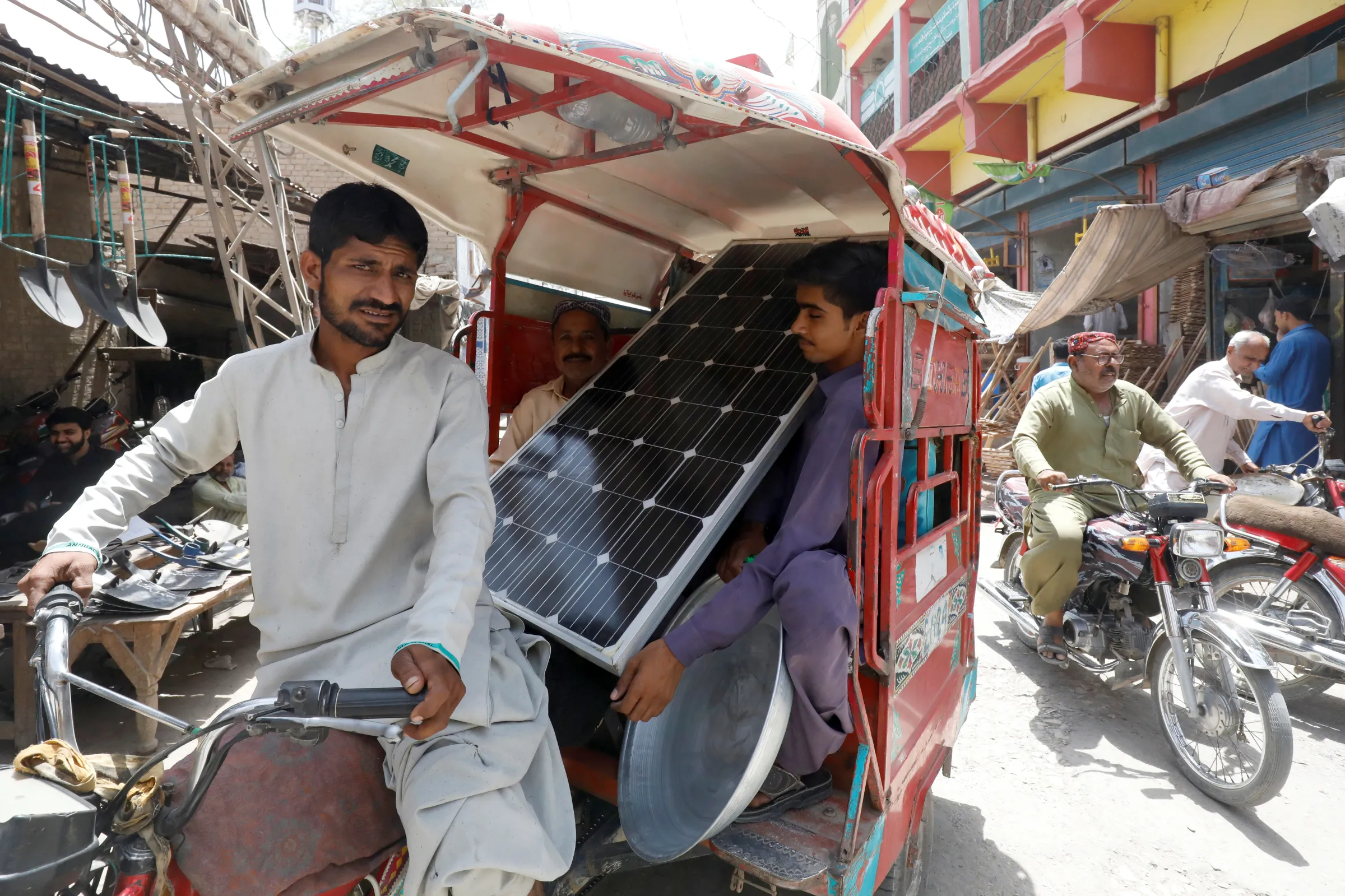Rooftop solar booms in Pakistan. How can neighbours catch up?

People in a rickshaw carry a solar panel, during a heatwave, in Jacobabad, Pakistan, May 14, 2022. REUTERS/Akhtar Soomro
What’s the context?
India and Pakistan have seen strong growth in the rooftop solar sector that offer lessons for the region.
DHAKA - South Asia has seen a rapid expansion in rooftop solar power generation in the last two years as the region tries to cut its reliance on polluting and often-imported fossil fuels like coal, oil and gas.
The most spectacular growth has happened in Pakistan, where rooftop solar power now accounts for a quarter of the country's electricity supply, according to the Institute for Energy Economics and Financial Analysis (IEEFA), a U.S. think tank.
Other South Asian countries lag far behind.
India, the region's largest renewable energy producer, boosted its rooftop solar capacity from about 11 gigawatts (GW), or 2.6% of the total energy mix in 2023, to 18 GW by May 2025, the IEEFA said. But that still only makes up 3.9% of the total generating capacity.
Sri Lanka also more than doubled its rooftop solar capacity from 516 MW in 2022 to 1,347 MW by the end of 2024. It now makes up 23% of the Indian Ocean island nation's energy capacity, the IEEFA study said.
But Bangladesh's rooftop solar sector has shown little momentum, with capacity at just 245 MW, or just below 1% of the energy supply.
How has rooftop solar boomed in Pakistan?
In Pakistan, the rooftop solar boom has been largely driven by market forces, according to REN21, a Paris-based think tank.
Pakistan saw electricity prices jump by 155% in three years, while solar panel prices fell by nearly 50% and were exempted from import duties and sales taxes, making solar power a cheaper alternative for households and farmers, said an analysis by the World Resources Institute (WRI), an international NGO.
Meanwhile, entrepreneurs trained themselves to install rooftop solar technology and spread its adoption to the local level, the WRI said.
What has India done to promote rooftop solar?
By contrast, India's solar expansion is driven by government plans and incentives, like a programme launched in February 2024 offering a total of 75 billion rupees ($9 billion) in subsidies to install 30 GW of capacity on about 10 million homes.
The country has already disbursed $1.05 billion in subsidies to 1.6 million households, according to the IEEFA.
India's overall rooftop solar potential could be as high as 960 GW, nearly double the country's current entire power generation of 500 GW, said the New Delhi-based think tank The Energy and Resources Institute (TERI) in a June 2025 report.
Why has Bangladesh not developed rooftop solar?
Densely populated Bangladesh should be ideally suited to rooftop solar power, but the country's homes and business have lacked affordable and accessible finance to do so, while high import duties on rooftop solar components also throttled quick adoption, said an IEEFA analysis in August.
In July, the government set a goal of adding 3GW capacity to be installed on government buildings, schools and hospitals across the country.
However, Bangladesh would need to train bank officials about financing solar projects, offer low-cost finance to solar energy businesses and waive import duties on solar components, said the IEEFA study.
Does everyone have access to rooftop solar?
No. The growth of rooftop solar power has often been uneven across regions and income groups.
In India, states like Gujarat, Maharashtra, or Kerala had rooftop solar capacity of about 6 GW, 4.1 GW and 1.6 GW respectively, while others like the northeastern states Manipur and Meghalaya had only 10.6 MW and 0.21 MW as of September 2025, said the country's Ministry of New and Renewable Energy.
In Pakistan, the national grid has a total installed generation capacity of 46 GW from all energy sources, though peak demand hovers between only 20 to 30 GW, said a report by Renewables First, an Islamabad-based think tank.
The government has to pay the power plants a capacity payment - a set fee based on the amount of power that plants can generate - even when they remain idle due to surplus capacity.
With a large number of wealthy consumers switching to solar and leaving the main grid, the demand for grid power has fallen.
The government, faced with capacity payment obligations nearly tripling to 2.1 trillion Pakistani rupees ($7.46 billion) in 2024 from 721 billion Pakistani rupees in 2022, has slapped a 10% tax on imported solar panels in this year's budget.
Meanwhile, utilities have put up prices. Grid-dependent poorer consumers, unable to switch to solar, were hardest hit.
($1 = 281.4000 Pakistani rupees)
(Reporting by Md. Tahmid Zami; Editing by Jack Graham and Jon Hemming.)
Context is powered by the Thomson Reuters Foundation Newsroom.
Our Standards: Thomson Reuters Trust Principles
Tags
- Clean power
- Adaptation
- Net-zero
- Climate policy
- Communicating climate change
- Energy access
- Green jobs
- Climate solutions














